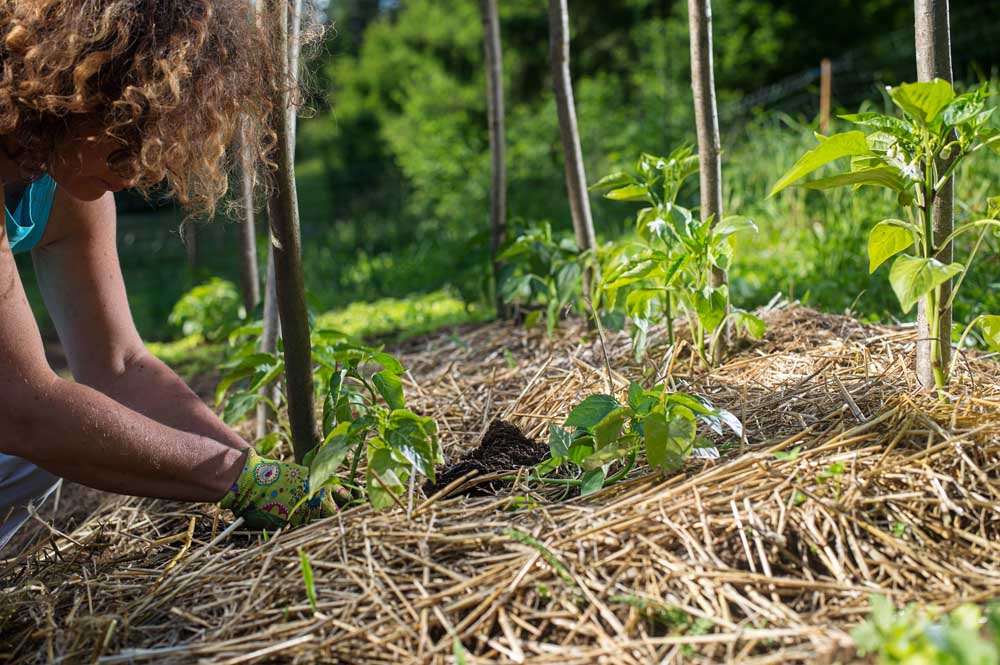GARDEN PLOTS: Is a thick layer of mulch a welcome mat for garden pests?
Published 6:00 am Wednesday, April 12, 2023

- A young gardener uses straw to mulch pepper plants. Ruth Stout, a proponent of using mulch in the garden, doesn't believe mulching makes pest problems worse.
“Some people believe that mulch attracts slugs, sowbugs, mice, rats and snakes, actually giving me the impression that they think I invented these animals just to make it hard for gardeners.”
— Ruth Stout in “Gardening Without Work: For the Aging, the Busy, and the Indolent,” 1961
“Gardening Without Work” is Ruth Stout’s second gardening book in which she describes her method of applying an 8-inch-thick layer of mulch year-round on top of her vegetable garden and flowerbeds. In between the first and second gardening books, Stout wrote a humorous volume about housekeeping and hospitality called “Company Coming” (way ahead of Martha Stewart), as well as a funny, timeless treatise for women on how to enjoy life called “It’s a Woman’s World” (way ahead of Gloria Steinem).
At the beginning of “Gardening Without Work,” Stout makes it clear that she didn’t want to write another gardening book but decided to do it anyway so she could respond to several hundred letters she’d received from gardeners who either applauded her ingenuous — or disparaged her ineffectual — system. In a chapter titled “All those pesky so-and-sos,” Stout shares her letters about, and her own experiences with, several garden pests.
My ears pricked up when I came to the part about mulch attracting slugs and sowbugs because I’ve had problems with slugs and a close relative to sowbugs, the pill bug or roly-poly. Both these creatures hide during the day and wreak havoc on my strawberries and tomatoes at night. Slugs are notorious for their destructive garden antics, but roly-polys, a favorite amusement for children everywhere because of the way they curl up into a ball to protect themselves, are supposedly not much of a concern.
Hogwash, as Stout emphatically states throughout her book whenever she divulges a bit of nonsense. Pill bugs might look playful, but they are actually armored adversaries in my vegetable garden. Kin to shrimp and crawfish, I’ve read, many pill bug species are edible when cooked (“tastes like shrimp”), but I don’t want to harvest pill bugs to eat them or slugs, which are related to snails/escargot and also are reputed to be edible when cooked (“tastes like buttery rubber”).
No, I want to hunt these pests mercilessly so I don’t have to share my real food with them. According to Stout, when gardeners use her method of mulching, hunting slugs and pill bugs is much easier because they conveniently congregate at the moist soil surface underneath the mulch and, thus, can be readily discovered and dealt with mercilessly. (Here is another reason I want to raise chickens.)
Stout dismisses the idea that slugs and other garden pests become a problem as a consequence of the mulch; instead, she insists garden pests are always around and it’s really a matter of which of the “pesky so-and sos” are most comfy-cozy in our particular soil conditions and microclimate. Slugs and pill bugs, my nemeses, are decomposers of organic matter, and they don’t care if the material is part of the soil or growing out of the soil. They become pests when 1) there isn’t enough organic material in the soil to satisfy their appetites, and/or 2) there aren’t enough predators in the garden to keep their population down.
After I wrote about Stout’s method last week, I received two emails from readers who wanted to share their experiences with mulching. John wrote, “Being old and indolent myself, I’m appreciating Ruth Stout’s approach to gardening.” On the other hand, Ann warned, “After a couple of years, [I] found seeds wouldn’t grow and small plants struggled. Finally discovered my garden had been infested with symphylans … I had to go back to vigorous tilling and had to use larger transplants.”
Symphylans are pale-bodied, soil-dwelling creatures that have 15 body segments, 12 pairs of legs, and a prominent set of twitching antennae. They are common crop pests in western Oregon, particularly in aerated soils that are rich in organic matter. Symphylans will feed on plant roots and above-ground plant parts and can be incredibly damaging. The more I read about symphylans, the more I feel a little silly worrying about slugs and pill bugs.
As it turns out, symphylans, slugs and pill bugs are all attracted to large pieces of raw potato placed on or near the soil’s surface underneath a thick layer of mulch. Leave the bait in place for a day or two and then scoop out the pests and dispose of them in a sealed container. The OSU Extension recommends this method for monitoring the presence of symphylans, rather than for eradicating them, though.
Slugs, pill bugs and earwigs are all attracted to the smell of beer, and I’ve had success planting tuna fish cans in soil half-filled with beer to reduce these pesky populations. Stout recommended this method to someone who wrote back, “I’m certainly not going to carry beer out to the garden for slugs. If they want beer, they can come in the house and ask for it, like everybody else.”






